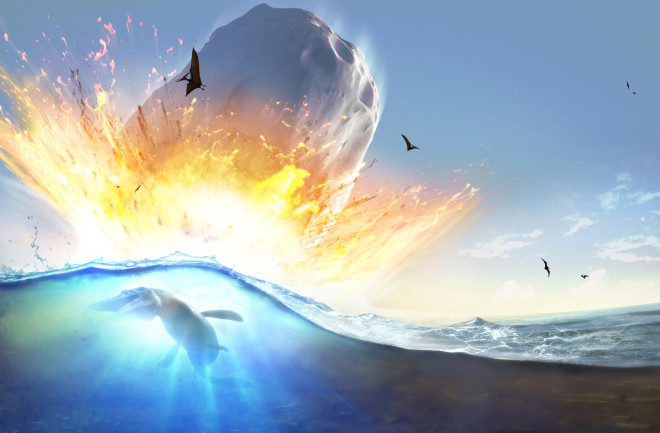For billions of years, it waited. A city-sized chunk of primordial space rock circled the solar system somewhere between the orbits of Mars and Jupiter. Earth took shape. Life evolved. And all the while, the space rock just drifted, tumbling end over end like a poorly thrown football. Then, some unknown celestial mechanics shoved this 9-mile-wide projectile out of its orbit. Destination: Earth.
The asteroid belt escapee arrived 66 million years ago. In those last dinosaur days, any skygazing T. rex might have tilted its head in curiosity as a strange, new star grew dozens of times brighter than the sun. Burning through the atmosphere at 45,000 mph, the asteroid’s leading edge hit the Gulf of Mexico while its other end was still higher than a cruising 747.
It excavated a hole nearly 20 miles deep, ripping fault lines down to Earth’s mantle. For two minutes, land behaved like liquid. The open hole left behind by the asteroid quickly filled back in as material rebounded from the depths, building a great ring of peaks around the crater’s center. Twelfth-magnitude earthquakes rocked the region. Cliffs crumbled. A blast of air surged at speeds exceeding 600 mph, bringing hurricane-force winds to what is now North America. Vegetation vaporized. Within the hour, waves hundreds of feet high pounded Texas and Florida. A debris plume erupted above Earth’s atmosphere and rained back down around the globe, creating regional infernos. These were just the opening salvos of hell on Earth.
By chance, the asteroid struck a shallow sea over a sulfur-rich shelf. Once vaporized, the chemicals formed a climate-altering blanket that enveloped the planet and fell as acid rain. Photosynthesis nearly stopped. As forests died, wildfires turned the world’s plants into a layer of soot now found all around the planet. Most of the remaining creatures — from the tiniest plankton to the largest dinosaurs — froze or starved. On land, nothing larger than 55 pounds survived.

